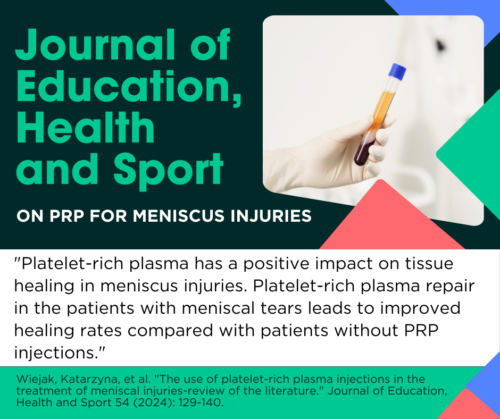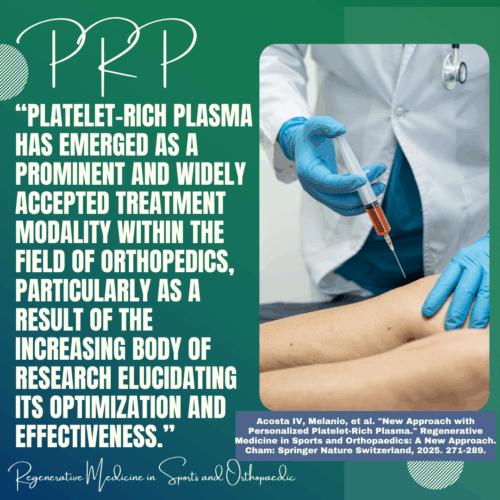
When patients face a joint injury, arthritis, or the possibility of surgery, they often seek an alternative. PRP, or platelet-rich plasma, is an effective non-surgical option for joint and spine repair. It also has enormous potential to reverse the physiology of osteoarthritis and increase cartilage volume.
PRP releases growth factors and proteins to promote tissue healing. Additionally, PRP enhances collagen synthesis and promotes the healing of bones and vessels, making it an effective treatment for tendon, ligament, muscle, and cartilage injuries. The risks of PRP injections are minimal as PRP is obtained from the patient’s own blood. (1)
Plasma is the fluid component of blood that contains cellular components, including red blood cells, white blood cells, and platelets. With PRP, your own blood is used. When concentrated through simple centrifugation, your blood plasma becomes “rich” in healing factors, hence the name Platelet-Rich Plasma. With PRP, the platelet-rich plasma is reintroduced into areas of joint injury, chronic joint weakness, or spine deterioration. These potent growth factors effectively repair tissue and regenerate the injury site.
PRP is a non-surgical procedure performed in our office. In fact, OrthoRegen® concentrates the platelets 7-10 times what is typically found in the blood. Other systems concentrate them, but to a lesser extent.
Joint repair using PRP is an exciting, cutting-edge therapy that stimulates tissue repair and regenerates weakened, torn, or damaged ligaments, tendons, menisci, and even cartilage.
PRP is an excellent treatment option for orthopedic and sports medicine. But do studies back up its use? In this article, we’ll quote extensive research demonstrating the effectiveness of PRP for joint repair. Hundreds of research papers have been published in medical journals worldwide that describe the benefits of PRP treatments.

Research reveals that PRP has a low risk. The Journal of Knee Surgery says, “PRP as a treatment option for cartilage damage or injury is attractive given the low rate of adverse events observed in numerous clinical studies (2).
Although PRP has gained considerable popularity in recent years, it has been around for decades. In 2012, the medical journal Arthritis Research and Therapy said, “Orthobiologics offer exciting new possibilities to promote and accelerate bone and soft tissue healing. PRP is an orthobiologic that has recently gained popularity as an adjuvant treatment for musculoskeletal injuries. The relative ease of preparation, applicability in the clinical setting, favorable safety profile, and possible beneficial outcome make PRP a promising therapeutic approach for regenerative treatments.”(3)
With PRP, the platelets are concentrated to provide an extensive reservoir of growth factors, resulting in a significant enhancement of the body’s natural healing process. Research shows that “PRP provides an abundance of growth factors in addition to other components that aid in joint health.” Plus, “autologous PRP therapy has demonstrated an excellent safety profile and has been shown effective for symptomatic osteoarthritis relief in numerous clinical studies.” (4)
PRP holds significant potential to alleviate joint pain, promote cartilage repair, and restore other joint tissues to a healthy state. Doctors describe the repair of PRP by saying, “Platelet-rich plasma is a safe, autologous, easy to prepare and to use, a relatively low-cost procedure to deliver growth factors for cartilage healing and regeneration.” (5)
Researchers in the Journal of Pain Research reviewing the benefits of PRP for knee arthritis found that patellofemoral cartilage volume and synovitis had significantly changed in the PRP group. PRP also decreased pain scores. (6)
The Physician and Sports Medicine journal says, “Given its biocompatibility and healing properties, percutaneous injections of PRP are used in athletes to treat tendon and muscle injuries. Studies of varying levels of evidence have demonstrated the safety and beneficial effects of PRP in these applications…” (7)

PRP Is Effective For Meniscus Injuries
The Journal of Orthopedic Surgical Research reviewed nine studies and 1164 participants to see if PRP was effective compared to other non-PRP treatments. What were the results? The PRP group was associated with a statistically significant pain improvement with a significantly lower failure rate. (8)
A standard treatment for meniscus tear repair is arthroscopy. However, “menisectomy often results in osteoarthritis 10-20 years after surgery.” In a 2024 article in the Journal of Education, Health, and Sport, researchers reported on the effectiveness of PRP, saying, “Platelet-rich plasma has a positive impact on tissue healing in meniscus injuries. Platelet-rich plasma repair in patients with meniscal tears leads to improved healing rates compared with patients without PRP injections.” (9)
Researchers in a 2025 article demonstrate that “PRP intervention might be particularly effective in addressing more severe meniscal tears. The results of our study provide compelling evidence for the positive impact of PRP augmentation in meniscus repair. Our findings indicate that PRP therapy has the potential to bring about substantial benefits for individuals with meniscus tears of the knee, particularly in terms of pain relief and enhanced functional capabilities. (10)
Is PRP better than hyaluronic acid injections? Researchers in the medical journal Medicine found the following after studying 1,350 patients with knee arthritis: “Compared with HA, PRP offers obvious advantages in the conservative treatment of knee osteoarthritis. Treatment with PRP can reduce long-term pain and improve knee joint function with no additional risks. Therefore, PRP can be widely used for the conservative treatment of knee osteoarthritis.” (11)
How does PRP stand up when compared to cortisone injections? Researchers in the Journal of Orthopedic Surgery concluded, “PRP demonstrated a statistically significant improvement over CS in a 1-year follow-up.” (12)
PRP is highly effective in repairing musculoskeletal tissue conditions, including moderate to severe tendon and ligament problems, as well as meniscus and labrum tears. It also works well for conditions such as carpal tunnel syndrome, Achilles tendonitis, tennis elbow, and more. Due to the vast amount of growth factors in platelets, PRP has enormous potential for repair in many joint and spine conditions.
PRP is promising in sports medicine, particularly for the treatment of tendon injuries, pain reduction, and improved function in articular injuries of the ankle, knee, and hip. It is also advocated as a safe procedure with negligible adverse effects. Due to its autologous (from your own body) nature, PRP injections are readily available and have a minimal risk of reactivity compared to other compounds.

Patients will receive the maximum benefit of PRP when it is offered as part of a comprehensive program for joint healing.
At OrthoRegen®, we offer PRP as part of a comprehensive Regenerative Orthopedic program that treats all affected soft tissue in the joint, including ligaments, tendons, and cartilage. Dextrose Prolotherapy is used in conjunction with PRP to achieve comprehensive treatment of the joint. Combining PRP with Prolotherapy allows for the most significant benefit in repairing the entire joint.
It is important to remember that PRP is just one type of Regenerative Orthopedic treatment available. At OrthoRegen®, we utilize various regenerative therapies, depending on the severity of the pain or injury. They include Prolotherapy, PRP, and stem cell therapy, all of which can provide effective and safe treatments for repairing acute injuries or chronic degenerative joint conditions, as well as avoiding elective surgery.
Peter A. Fields, MD, DC, is a medical doctor, chiropractor, and founder of OrthoRegen®. He has successfully treated patients with Regenerative Orthopedics for many years. He is a leading expert in using PRP, Prolotherapy, and Stem Cells to resolve painful joint and spine conditions, as well as sports injuries. Dr. Fields is passionate about helping his clients achieve optimal long-term results by eliminating pain through PRP and other regenerative treatments.
(1)Kim, James, et al. “Google Trends Shows Increased Public Interest in Platelet-Rich-Plasma Injections in All Joints: Shoulder and Knee Show Greatest Increase.” Arthroscopy, Sports Medicine, and Rehabilitation (2025): 101199.
(2) Mascarenhas, Randy, et al. “Role of platelet-rich plasma in articular cartilage injury and disease.” The journal of knee surgery 28.01 (2015): 003-010.
(3) Dhillon RS, Schwarz EM, Maloney MD. Platelet-rich plasma therapy – future or trend? Arthritis Res Ther. 2012 Aug 8;14(4):219.
(4) Parrish, William Richard, and Breana Roides. “Platelet-rich plasma in osteoarthritis: more than a growth factor therapy.” Musculoskeletal Regeneration 3 (2017).
(5) Civinini, R., Nistri, L., Martini, C., Redl, B., Ristori, G., & Innocenti, M. Growth factors in the treatment of early osteoarthritis. Clinical Cases in Mineral and Bone Metabolism, 10(1), 26-29. https://doi.org/10.11138/ccmbm/2013.10.1.026
(6) Raeissadat, Seyed Ahmad, et al. “MRI changes after platelet-rich plasma injection in knee osteoarthritis (randomized clinical trial).” Journal of Pain Research (2020): 65-73.
(7) Mei-Dan, Omer, et al. “Autologous platelet-rich plasma: a revolution in soft tissue sports injury management?” The Physician and Sports Medicine. 38.4 (2010): 127-135.
(8)Li Z, Weng X. Platelet-rich plasma use in meniscus repair treatment: a systematic review and meta-analysis of clinical studies. J Orthop Surg Res. 2022 Oct 8;17(1):446. doi: 10.1186/s13018-022-03293-0. PMID: 36209223; PMCID: PMC9548158.
(9) Wiejak, Katarzyna, et al. “The use of platelet-rich plasma injections in the treatment of meniscal injuries-review of the literature.” Journal of Education, Health and Sport 54 (2024): 129-140.
(10) Raju, Prabakar Singh, et al. “Efficacy of Ultrasound-Guided Injection of Platelet-Rich Plasma in Treatment of Sports-Related Meniscal Injuries.” Indian Journal of Radiology and Imaging 35.01 (2025): 010-016.
(11) Chen, Z., Wang, C., You, D., Zhao, S., Zhu, Z., & Xu, M. (2020). Platelet-rich plasma versus hyaluronic acid in the treatment of knee osteoarthritis: A meta-analysis. Medicine, 99(11). https://doi.org/10.1097/MD.0000000000019388
(12) Elksniņš-Finogejevs, A., Vidal, L. & Peredistijs, A. Intra-articular platelet-rich plasma vs corticosteroids in the treatment of moderate knee osteoarthritis: a single-center prospective randomized controlled study with a 1-year follow up. J Orthop Surg Res 15, 257 (2020). https://doi.org/10.1186/s13018-020-01753-z